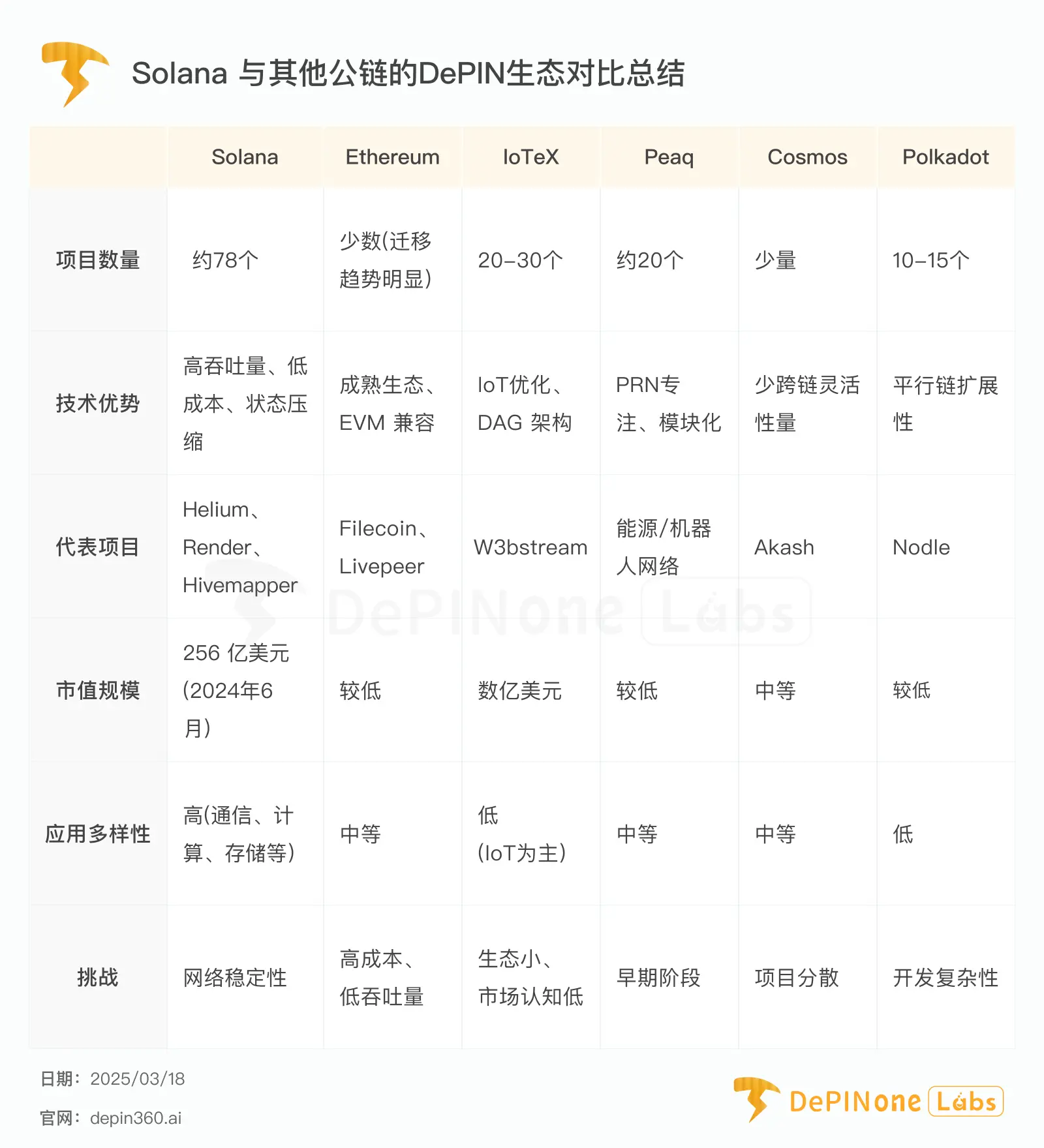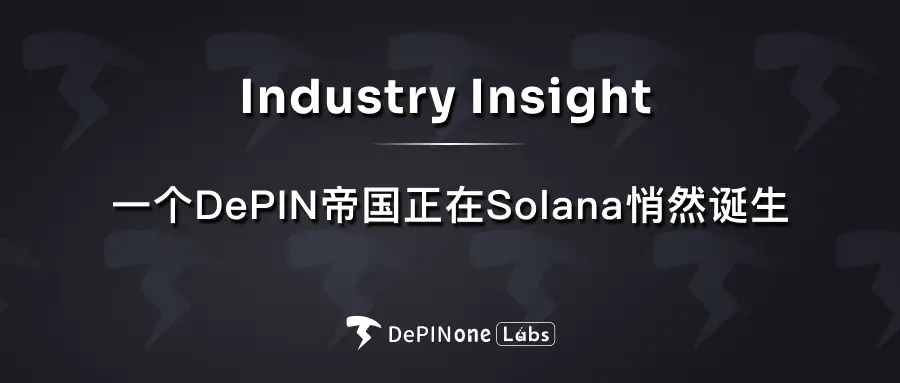This month, Solana’s DePIN ecosystem welcomed two new champions. The ROAM project, based on shared WiFi, launched on major exchanges like Bybit and Kucoin on March 6, reaching the fourth position in the DePIN sector in terms of node count, with hardware devices achieving the top rank across the network. Austin Federa, former strategic director of the Solana Foundation, led a financing round of $28 million with Solana co-founders and top VCs like Dragonfly and Multicoin, launching the distributed bandwidth project DoubleZero, aimed at creating a communication highway for web3 based on web2 infrastructure, which is expected to fundamentally address the network latency issues currently faced by web3.
Additionally, as of March 14, 2025, we observed significant development in the Solana-based DePIN ecosystem, with a market capitalization exceeding $25 billion and approximately 78 DePIN projects covering various subfields such as wireless communication (e.g., Helium), computing resources (e.g., Render Network), geolocation (e.g., Hivemapper), and cloud storage (e.g., GenesysGo SHDWDrive).
Solana is becoming the preferred platform for DePIN projects due to its high throughput, low transaction costs, mature developer ecosystem, and a large number of user supporters. We are witnessing the emergence of a DePIN empire ecosystem nurtured by Solana.
1. DoubleZero——Building a Highway for Web3 on Solana
On March 10, amidst a sluggish overall crypto market, another dark horse project in DePIN, DoubleZero Foundation, secured a massive investment of $28 million from top VCs.
What exactly is DoubleZero Foundation, and how was it able to secure such a significant investment despite the overall market downturn?
I summarize the core points as follows:
++* (1) The founding team has rich experience in blockchain projects and has achieved success, in addition to having many resources in the industry and a luxurious ecosystem.++
Austin Federa, the founder of DoubleZero, was previously the Head of Strategy at the Solana Foundation and can be considered one of the key drivers behind the early rise of the Solana ecosystem. During his time at the Solana Foundation, he was responsible for global market strategy and directly participated in several key projects, such as promoting the integration of USDC and USDT on Solana and even deeply engaging in ecosystem collaborations during the FTX era.
At the same time, Austin Federa has strong relationships with the core Solana team (including Anatoly Yakovenko and Raj Gokal), which allowed DoubleZero to gain resource support and market recognition from the Solana ecosystem early on.
++ (2) The investment team is prestigious, with Solana founders jointly investing, clearly supporting Solana’s DePIN strategic layout.++
The image below shows the investor team of DoubleZero. If you are familiar with the investment landscape in the crypto space, you will know the significant influence of Dragonfly and Multicoin. They are not only long-term supporters of the Solana ecosystem but have also played important roles in several key projects (e.g., Multicoin’s early bet on Solana, Dragonfly’s involvement in Serum).
Moreover, in addition to top VCs, the funding power within the Solana ecosystem also played a core role in this financing round, with Solana Ventures and co-founders Anatoly Yakovenko and Raj Gokal participating as angel investors.
From a somewhat irrational perspective, this is almost equivalent to announcing to others that this is my beloved child.
It is worth noting that the investment in DoubleZero came right after the Solana Foundation announced its DePIN ecosystem strategy, making it the first project to receive clear investment.
Thus, we believe that the Solana official support is significant; Austin is not acting alone but is bringing the entire resource pool of Solana into play, representing a comprehensive tilt of funds, technology, and market resources. This is undoubtedly an important signal for the entire DePIN sector: the Solana ecosystem is actively laying out a physical infrastructure network, and DoubleZero may be the “vanguard” leading the charge.
++ (3) Leading technical solutions, building a highway for web3, allowing web3 projects to operate as smoothly as web2;*++
We know that the Web3 sector currently faces many issues, particularly at the infrastructure level, where limitations of public internet bandwidth and non-deterministic routing often prevent Web3 projects from operating as smoothly as Web2. Even if the issues of public bandwidth limitations and non-deterministic routing are resolved, if the latency issues between validators cannot be addressed, then Web3 projects will still not operate as smoothly as Web2.
DoubleZero was born to solve these infrastructure-level issues in web3.
From the architecture shown in the above image, we can see DoubleZero’s unique Two-Ring Architecture. The Outer Ring connects to the public internet, using hardware (such as FPGAs) for attack protection, signature verification, and transaction filtering, while the Inner Ring processes the filtered traffic through dedicated bandwidth lines and builds consensus.
First, the Outer Ring connects to the public internet, using hardware (such as FPGAs) for attack protection, signature verification, and transaction filtering;
The benefit of this is that it pre-filters incoming junk and duplicate transactions through dedicated hardware, reducing the burden on validators and allowing the blockchain to share filtering resources without each validator needing to provide them individually.
Secondly, the Inner Ring processes the filtered traffic through dedicated bandwidth lines and builds consensus. It can improve communication efficiency through clear message routing, tracking, and priority management.
In terms of the specific technical processing flow, the official disclosed information states:
(1) The Outer Ring serves as the first line of defense, primarily responsible for filtering out junk transactions, DDoS attacks, and invalid traffic from malicious contract calls. It uses an adaptive traffic filtering mechanism, leveraging machine learning and heuristic rules to analyze transaction patterns in real-time, accurately identifying and intercepting malicious traffic, ensuring that only valid transactions can enter the blockchain mainnet.
At the same time, the Outer Ring relies on decentralized zero-permission fiber contributions from independent contributors in the network to provide physical infrastructure, further ensuring the authenticity and priority of data packets. All transactions must pass through the basic validity screening of the Outer Ring before entering the Inner Ring, reducing invalid transactions from entering the core network and improving overall processing efficiency.
(2) Transactions entering the Inner Ring have undergone strict screening, allowing it to focus on efficient transaction processing. The Inner Ring adopts a high-performance architecture similar to Solana, supporting ultra-high TPS (transactions per second) and ensuring extremely short transaction confirmation times to meet the demand for a large number of transactions.
To further enhance network fluidity, DoubleZero also employs a stateless validation model, which, compared to the traditional blockchain state storage model, makes the entire network run more smoothly and efficiently.
2. Roam——A Web3 Version of Starlink Built on Solana
On March 6, another decentralized wireless network project based on the Solana public chain, Roam, launched on Kucoin and Bybit, with a circulating market value exceeding $60 million, adding another strong player to the DePIN sector.
(1) What is Roam?
ROAM is a decentralized wireless network project based on the Solana blockchain, aiming to provide seamless, secure WiFi and eSIM connections globally, with the goal of building an open wireless network worldwide. It utilizes blockchain technology to achieve automatic network switching and secure connections, supporting individuals, smart devices, and AI agents.
Currently, it has over 2.3 million users and 2 million WiFi nodes, covering more than 190 countries, ranking high in the DePIN field.
The token $ROAM has a total supply of 1 billion, with 600 million allocated for mining and community activities, allowing users to earn tokens by providing WiFi or validating the network.
According to Messari’s 2024 report, ROAM ranks fourth among DePIN projects with over 1 million active nodes and holds the top position in terms of hardware node count. Competitors include Helium and DIMO, but ROAM’s global coverage and user scale provide it with an advantage.
If Elon Musk’s Starlink has built a communication system based on outer space, I would like to refer to Roam as the web3 version of a Starlink system based on terrestrial communication networks.
(2) Technical Advantages
ROAM utilizes OpenRoaming™ WiFi and eSIM technology, allowing users to access WiFi or share network performance data while ensuring that users do not face data leakage risks during WiFi sharing and usage through decentralized identity (DID) and verifiable credentials (VC), ensuring privacy and security.
The specific technical architecture and functions are as follows:
- OpenRoaming™ Wi-Fi: Adhering to Wireless Broadband Alliance (WBA) standards, it supports seamless switching between different WiFi networks, ensuring continuous connectivity.
- eSIM Services: Provides smart eSIM services in over 160 countries, allowing users to access data networks without traditional SIM cards.
- Blockchain Incentive Mechanism: Adopts a Proof-of-Service mining algorithm, allowing users to earn ROAM tokens by providing WiFi services or validating network performance.
- Decentralized Identity (DID) and Verifiable Credentials (VC): Uses blockchain technology to protect user privacy, eliminating reliance on centralized validators, enhancing security and decentralization.
In this system design, OpenRoaming™ Wi-Fi addresses the link protocol issues of communication systems in different countries and regions, while eSIM resolves the lack of SIM services in many areas, helping to create communication conditions in impoverished regions. DID and VC technology solve data security and privacy issues during communication, introducing a web3 economic system that can quickly stimulate early network construction issues.
The rapid growth of ROAM since its rebranding in 2024 can be attributed not only to the siphoning effect of the Solana ecosystem but also to its own technological and sectoral accumulation.
(3) Operational Advantages
The project team has been deeply involved in the web3 sector for many years, well-versed in web3 project strategies, and has quickly accumulated network effects and initial users through web3’s idle sharing incentive models.
ROAM encourages users to participate in network construction through a mobile application, such as adding WiFi nodes, daily check-ins, or inviting friends to earn Roam Points, which can be exchanged for ROAM tokens after the token generation event (TGE).
From the project’s team profile, we can see that although the ROAM project officially started on April 2, 2024, it was previously known as MetaBlox, which was established in 2018. After years of dormancy without significant progress, it rebranded to ROAM and migrated to the Solana mainnet in 2024. This indicates that the success of any project is the result of years of deep cultivation in the sector, so even during the current market downturn, we believe that good projects can still transcend time cycles and bloom roses of time.
In summary, ROAM provides an excellent wireless network sharing project and has already formed a strong network effect. Currently, its circulating market value is only around $15 million, far from Grass’s $360 million. If we can see more users participating in the ROAM network, we may witness the project’s rise and emergence in the next bull market.
As of March 14, 2025, we have observed significant development in the Solana-based DePIN ecosystem, with a market capitalization exceeding $25 billion, far surpassing the scale of DePIN projects in other ecosystems. We are witnessing an empire of DePIN ecology being nurtured on Solana.
According to publicly available data, there are approximately 78 DePIN projects on Solana (data referenced from platforms like Messari and DePIN Scan as of 2024), covering various subfields such as wireless communication (e.g., Helium), computing resources (e.g., Render Network), geolocation (e.g., Hivemapper), and cloud storage (e.g., GenesysGo SHDWDrive). Solana’s high throughput (theoretically up to 50,000 TPS), low transaction costs (about $0.00025 per transaction), and mature developer ecosystem make it the preferred platform for DePIN projects.
Current representative DePIN projects on Solana include:
- Helium: The world’s largest decentralized wireless network, which has deployed nearly 1 million hotspots covering 192 countries and providing IoT and 5G services after migrating to Solana.
- Render Network: A decentralized GPU computing platform that migrated from Ethereum to Solana, having processed tens of millions of frames of image data, supporting AI and media rendering.
- Hivemapper: A decentralized digital mapping network that challenges Google Maps through user-contributed dashcam data, covering multiple cities.
- GenesysGo SHDWDrive: A decentralized cloud storage solution attempting to fill the gap in the Solana ecosystem in the storage field.
- Dabba Network (emerging project): Focused on the Indian broadband market, enhancing network coverage through decentralization.
The total market capitalization of Solana’s DePIN projects reached approximately $25.6 billion in June 2024 (DePIN Scan data), and it may fluctuate in 2025 due to market volatility and project growth. Leading projects like Helium, Render, and Hivemapper have fully diluted valuations (FDV) exceeding $10 billion.
From the above table, it is evident that Solana has a significant advantage in the DePIN sector compared to other public chains:
- In terms of technical performance and cost advantages, Solana’s high performance and low cost, especially its low gas fees, are particularly friendly to DePIN projects (such as micro-payment incentives) that require frequent transactions compared to public chains like Ethereum.
- Proof of History (PoH) and parallel processing capabilities enable it to handle large amounts of real-time data for DePIN projects (such as IoT device communication and map data uploads), allowing DePIN projects to operate smoothly and comfortably like web2 projects.
- In the public chain ecosystem, the Solana Foundation actively promotes the development of DePIN projects through funding and hackathons (such as collaborations with Multicoin Capital). Recently, it also established a special fund for Solana DePIN, aiming to help Solana nurture more high-quality projects, with the first project being DoubleZero, currently the most well-known one.
Therefore, we optimistically believe that Solana is not merely a memecoin public chain; its journey to today is not solely due to its MEME effect but rather its solid ecological foundation, technical advocacy, and strong support for the community and projects. We are optimistic that the next DePIN empire ecosystem may be born on Solana.
1. On February 1, IoTeX, a DePIN and AI fully-chain compatible modular infrastructure, released its 2025 development roadmap, focusing on the DePIN + AI ecosystem:
- DePIN Empowered Physical Perception AI
IoTeX has launched an open-source framework called QuickSilver that combines large language models (LLMs) with DePIN network data to create high-level AI applications, planning to launch the QuickSilver testnet in the first quarter, allowing developers to connect the existing DePIN world with the emerging AI world to create a wave of new “perceptible AI applications.”
- Establishing DePIN + AI Strategic Reserves
IoTeX will create an initial BTC-based DePIN + AI asset strategic reserve for IOTX holders. This reserve will serve as a “vault” for long-term quality tokens and assets, safeguarding the interests of IOTX holders.
A comprehensive community empowerment plan, combined with a DAO-based governance model, will allow the community to participate directly in the development of IoTeX.
2. On March 3, during the ETHDenver 2025 event, a forward-looking dialogue on the regulatory framework for cryptocurrency and DePIN + AI was held at the DePIN + AI R3al World Summit, featuring Salah, policy director of the Blockchain Association, and Larry, head of the IoTeX ecosystem, sparking deep industry reflections on technological integration and policy trends.
Salah emphasized: “Current U.S. regulatory agencies are accelerating their exploration of how to incorporate innovative technologies like DePIN, which merge the physical and digital worlds, into the national strategic framework. Future regulatory frameworks must balance technological innovation with public interest, and the transparency of DePIN and the explainability of AI may become key to solving regulatory challenges.”
Larry shared IoTeX’s practical experience: “From compliance collaborations with Grayscale and Coinbase to co-chairing the Blockchain Association’s DePIN working group, we have always centered on ‘verifiable physical data’ to align DePIN + AI with the needs of the real economy.”
3. On March 6, the Solana Foundation and the Solana Chinese community Solar will hold a DePIN Day event in Shenzhen, the hardware capital, on March 8.
Emerging DePIN projects in the Solana ecosystem, including Cudis, Starpower, Geodnet, Roam, Aethir, Gradient, and DeGlass, will attend and share their presentations on-site.
1. On February 27, Solana ecosystem DePIN project Shaga completed a $4 million seed round financing, led by IOSG Ventures, with participation from Everyrealm, Amber Group, and several angel investors.
Shaga aims to reshape the gaming industry by breaking hardware limitations and delivering ultra-low latency, making high-performance gaming accessible.
BlockBeats previously reported that on June 25, 2024, Shaga completed a $1 million angel round financing, led by Arca, with participation from MARIN DIGITAL VENTURES, Skybridge20 Ventures, Aurory, Quotient Ventures, and angel investors including Solana co-founder Anatoly Yakovenko and Helium founder Amir Haleem.
2. On February 25, DePIN project Geodnet completed an $8 million token financing, led by Multicoin.
Geodnet provides financial incentives for startups, encouraging ordinary people to host physical infrastructure. Due to strong demand for Geodnet’s services, the project’s token (its incentive mechanism) has more than doubled in the past 12 months.
In April last year, the GEODNET Foundation announced it had completed over $2 million in strategic financing, with participation from CoinFund, Pantera Capital, VanEck, and Santiago R. Santos. The additional funds will support the foundation in achieving its short-term goals, including decentralization and developer usability.
3. On February 5, DePIN gaming infrastructure platform Beamable completed a $13.5 million Series A financing, led by Bitkraft Ventures.
Beamable Network aims to change the way game backend infrastructure is built and operated.
4. DoubleZero Foundation announced it has secured $28 million in investment led by Dragonfly and Multicoin Capital.
DoubleZero is a project based on the DePIN sector that allows anyone to contribute independent fiber links without permission, essentially paving the “information highway” for the Web3 world. The project’s biggest highlight is its hardware-driven nature, directly targeting the infrastructure layer. DoubleZero’s goal is simple: to increase bandwidth and reduce latency for all high-performance blockchains.
ChainCatcher reminds readers to view blockchain rationally, enhance risk awareness, and be cautious of various virtual token issuances and speculations. All content on this site is solely market information or related party opinions, and does not constitute any form of investment advice. If you find sensitive information in the content, please click “Report”, and we will handle it promptly.





